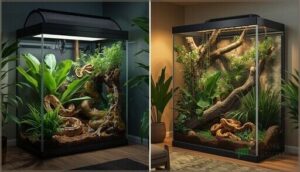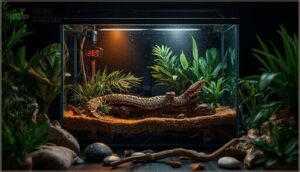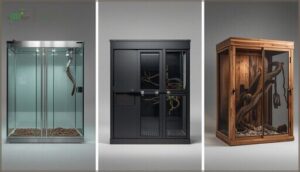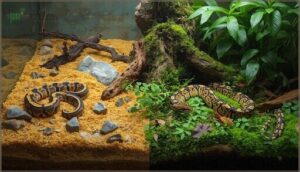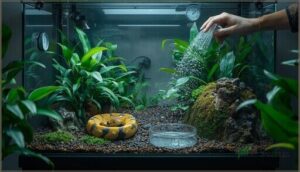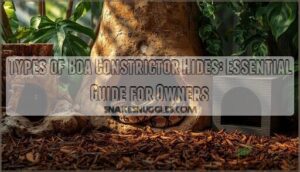This site is supported by our readers. We may earn a commission, at no cost to you, if you purchase through links.
Your snake’s enclosure isn’t just a container—it’s the entire world they’ll experience throughout their life. A ball python crammed into a 20-gallon tank doesn’t just lack space; they lose the ability to thermoregulate properly, explore natural behaviors, and maintain the muscle tone that comes from stretching their full body length.
Research consistently shows that snakes housed in appropriately sized enclosures exhibit lower stress hormones, better feeding responses, and fewer health complications than those in cramped quarters.
Understanding snake species habitat requirements means recognizing that different species—from terrestrial corn snakes to arboreal green tree pythons—demand distinctly different spatial arrangements, temperature zones, and environmental features. Getting these fundamentals right from the start prevents years of behavioral issues and veterinary interventions down the road.
Table Of Contents
Key Takeaways
- Proper enclosure size directly impacts your snake’s physical health and behavioral diversity—undersized habitats trigger stress hormones, muscle atrophy, respiratory infections, and feeding refusal, while adequate space allows full-body stretching, natural thermoregulation, and species-specific behaviors that prevent years of veterinary interventions.
- Species-specific habitat design is non-negotiable because terrestrial snakes like ball pythons need expansive floor space (minimum 4′ x 2′ x 2′), arboreal species like green tree pythons require vertical height matching their body length with climbing structures, and aquatic snakes demand balanced water-to-land ratios—each setup requiring distinct substrate, temperature gradients, and humidity levels tailored to their evolutionary adaptations.
- Environmental control through proper temperature zoning (90°F warm side, 75-85°F cool side), humidity management (40-90% depending on species), and enrichment elements like multiple hides and climbing structures creates the physiological conditions snakes need to regulate body temperature, shed successfully, and express natural behaviors that directly strengthen immune function and cognitive health.
- Consistent habitat maintenance including daily spot cleaning, weekly environmental monitoring with digital hygrometers and thermostats, and species-appropriate substrate selection (moisture-retaining coconut fiber for tropicals, dry aspen for desert species) prevents the mold growth, bacterial colonization, and toxic substrate exposure that cause respiratory disease, impaction, and zoonotic health risks.
Why Snake Habitat Size Matters
Your snake’s enclosure size isn’t just about providing space—it directly shapes their physical health, mental well-being, and ability to express natural behaviors. When housing falls short, you’ll see stress-related problems ranging from feeding refusal to serious health complications.
Understanding why proper dimensions matter will help you create a habitat that fosters your snake’s long-term thriving, not just survival.
Impact on Health and Behavior
When you provide adequate space, your snake’s behavioral diversity flourishes—they stretch, explore, and thermoregulate naturally. Cramped conditions trigger physiological stress, muscle atrophy, and behavioral issues that compromise snake health and behavior.
Adequate space allows snakes to stretch, explore, and thermoregulate naturally, while cramped conditions trigger stress, muscle atrophy, and behavioral problems
Studies show snakes prefer enclosures exceeding their body length, spending more time elongated and active. Meeting these spatial needs isn’t just practical—it’s fundamental to snake wellbeing and ethical welfare standards. A recent study highlighted potential welfare concerns for snakes kept in enclosures shorter than their body length.
Risks of Inadequate Enclosure Size
Undersized enclosures trigger serious health problems you’ll want to avoid. When your snake can’t stretch fully, these risks multiply:
- Muscle atrophy and obesity develop from restricted movement and exercise
- Respiratory infections and skin conditions arise from poor ventilation and waste buildup
- Stress indicators like repetitive pacing and feeding refusal become common
- Disease incidence increases as cramped spaces complicate hygiene maintenance
These behavioral issues directly compromise your snake’s immune function and longevity, making adequate space non-negotiable for responsible care. Current laws often restrict snake’s ability to stretch fully.
Importance of Full Body Extension
Your snake’s ability to fully stretch is fundamental to muscular health and stress reduction. Scientific studies confirm that snakes demonstrate comfort through rectilinear extension—stretching from head to tail—and this behavioral need directly influences your enclosure size decisions.
At minimum, your snake habitat must match your snake’s body length, though many species thrive with additional space utilization that meets these ethical minimums for responsible care.
Ethical Considerations in Housing
Housing your snake ethically extends beyond meeting basic space requirements. Welfare research shows that captive vs. wild origins, responsible breeding practices, and environmental enrichment all influence long-term health outcomes.
Consider these ethical considerations in snake housing:
- Source captive-bred snakes to reduce conservation impact on wild populations
- Provide space and welfare standards that allow natural behaviors
- Maintain proper environmental controls for humane treatment
- Support responsible breeding rather than wild collection
- Guarantee animal welfare through adequate reptile welfare practices
Species-Specific Habitat Requirements
Not all snakes live the same way, and your enclosure setup needs to reflect that. A ground-dwelling ball python has completely different needs than a tree-climbing green tree python or a water-loving garter snake.
Let’s look at how terrestrial, arboreal, and aquatic species differ, plus specific guidelines for popular pet snakes and their younger counterparts.
Terrestrial, Arboreal, and Aquatic Needs
Understanding your snake’s lifestyle—terrestrial, arboreal, or aquatic—is the foundation for proper habitat setup. Each category demands distinct enclosure priorities, from substrate depth to vertical space, and recognizing these species-specific requirements ensures your snake thrives.
| Habitat Type | Key Features | Priority Focus |
|---|---|---|
| Terrestrial | Ground-level hides, moisture-retaining substrates (coconut husk, cypress mulch), burrowing space | Floor space over height, substrate depth 2-3 inches minimum |
| Arboreal | Climbing branches, elevated perches, live or artificial foliage for camouflage | Vertical space prioritized, enclosure height matching body length |
| Aquatic/Semi-aquatic | Water features for submersion, dry basking zones, sealed non-porous materials | Balance of aquatic and terrestrial areas, easy-clean substrates |
Terrestrial species require spacious floor plans supporting natural movement, while arboreal species need tall enclosures with enrichment strategies like sturdy branches. Aquatic snakes demand habitat complexity combining swimming zones with secure land areas, and all setups benefit from species-specific temperature gradients and humidity control.
Ball Python and Corn Snake Enclosure Guidelines
For ball pythons, you’ll need enclosures measuring at least 36″ x 18″ x 12″, though 4′ x 2′ x 2′ better bolsters their well-being. Corn snakes require similar floor space—4′ x 2′ x 2′ minimum—but benefit from additional height (3-4 feet) to accommodate climbing behavior.
PVC advantages include enhanced humidity retention and durability, while glass limitations center on heat dissipation and moisture control challenges.
Both species demand secure lids, multiple hides, and heating elements creating proper thermal gradients for escape prevention and health.
Baby and Juvenile Snake Enclosure Sizes
Your hatchlings need smaller starter enclosures—usually 10-gallon tanks for newborns measuring 10-17 inches—to prevent feeding refusal and stress.
As juvenile snakes progress through their first year, you’ll upgrade from 20-gallon to 40-gallon setups, matching growth progression with appropriate substrate depth, secure hiding spots, and thermal zones.
Space enrichment becomes critical during juvenile development, as proper snake age and enclosure size alignment directly aids muscle tone, thermoregulation abilities, and natural behaviors.
Key Factors for Proper Enclosure Setup
Once you’ve chosen the right enclosure size for your snake, setting up the interior environment correctly becomes your next priority. Your snake’s health depends on three interconnected factors working together: proper temperature zones, stable humidity levels, and thoughtful enrichment elements.
Let’s break down each component so you can create a habitat that encourages your snake’s natural behaviors and physiological needs.
Temperature Gradients and Zoning
Temperature gradients allow your snake to self-regulate body temperature by moving between warm and cool zones. You’ll need distinct thermal zones: corn snakes thrive with a warm side around 90°F and a cool side between 75-82°F, while ball pythons require 90-92°F basking areas with cooler zones at 80-85°F.
- Use heat mats, ceramic emitters, or heat tape as heat source types
- Install thermostat regulation to prevent dangerous overheating
- Position digital thermometers for accurate gradient monitoring
- Recognize species differences—tropical snakes need narrower ranges
Poor thermal regulation causes digestive problems, weakened immunity, and stress behaviors.
Humidity Control and Ventilation
Maintaining proper humidity control and ventilation prevents respiratory infections and ensures shedding success. You’ll need a digital hygrometer for humidity monitoring—ball pythons require 40-60% humidity levels, while tropical species need 70-90%.
Use misting techniques, moisture-retentive substrate like sphagnum moss, and strategic vent placement for ventilation safety. Balance airflow without creating drafts that compromise humidity control and ventilation stability.
Enrichment, Hides, and Climbing Structures
Environmental enrichment transforms enclosures from sterile boxes into active spaces that promote natural behaviors and cognitive engagement. Enrichment benefits include reduced stress, improved problem-solving abilities, and increased activity levels.
You’ll need at least two hides—one on the warm side, one on the cool—plus branches or driftwood for climbing safety. Secure all climbing structures properly, and rotate enrichment items regularly to maintain behavioral impact through novelty and sensory stimulation.
Choosing The Right Enclosure Type
The right enclosure material affects everything from temperature control to long-term durability, so it’s worth getting it right from the start.
You’ll also need to think about security features that prevent escapes and sizing calculations that match your snake’s specific needs.
Let’s walk through the main options and what makes each one work—or not work—for different species and setups.
Glass Vs. PVC and Plastic Enclosures
When selecting your snake’s home, you’ll face a fundamental choice between glass terrariums and plastic/PVC enclosures, each offering distinct advantages for temperature regulation, humidity control, and long-term durability.
- Heat retention: PVC enclosures maintain stable temperature zones up to 20% longer than glass, reducing energy costs
- Material durability: PVC resists warping and cracking, while glass tanks may chip or develop failing silicone seams
- Humidity control: PVC’s low permeability sustains moisture levels more effectively than glass with screen lids
- Weight comparison: PVC units weigh considerably less, simplifying relocation and multi-tank setups
- Visual aesthetics: Glass provides better viewing clarity, though PVC’s opacity reduces stress for security-oriented species
Secure and Escape-Proof Designs
Beyond material choice, you’ll need locking mechanisms that prevent the escape attempts snakes are surprisingly skilled at. Wire locks on sliding glass doors reduce accidental openings, while showcase locks secure front-opening designs against persistent nudging. Double locking systems—combining wire locks with mechanical latches—offer the most reliable escape prevention, particularly for venomous species where regulatory compliance demands fail-safe containment.
Ventilation safety requires fine mesh screening that maintains airflow without creating squeeze-through gaps.
Enclosure Size Calculations (Length, Width, Height)
Once your enclosure’s security measures are in place, calculating minimum length, width, and height ensures your snake can actually thrive. Proper enclosure size isn’t guesswork—it’s based on body length and species-specific needs. For terrestrial snakes, combine length plus width to equal or exceed your snake’s full body length, while arboreal species need height matching their stretched-out measurement.
Three volume calculation essentials for different growth stages:
- Hatchlings to juveniles: Start with enclosures offering half the projected adult dimensions, upgrading as your snake grows to prevent stress-induced feeding refusal while maintaining appropriate surface area for thermoregulation.
- Adult terrestrial species: A 4-foot corn snake requires at least 4′ x 2′ floor space (approximately 432 liters total volume), ensuring adequate space utilization for movement and behavioral diversity beyond simple coiling.
- Arboreal and aquatic specialists: Green tree pythons need vertical enclosures exceeding body length, while aquatic species require water zones measuring four times body length in width—geometric concerns that fundamentally reshape your habitat planning.
These calculations account for the snake’s need to stretch fully, establish thermal gradients, and exhibit natural behaviors that directly impact long-term health.
Selecting and Maintaining Substrate
Choosing the right substrate isn’t just about aesthetics—it directly affects your snake’s health, behavior, and how easily you can maintain their environment. Different species have evolved to thrive on specific ground materials, from sandy desert substrates to moisture-retaining forest bedding.
Let’s break down how to match substrate types to your snake’s natural needs, keep them clean and safe, and create a setup that works for both of you.
Substrate Types by Species
Your substrate selection directly impacts your snake’s respiratory health, humidity retention, and burrowing needs. Ball pythons thrive on aspen bedding or coconut fiber that maintains moderate humidity, while desert species like sand boas prefer dry blends mimicking arid environments. Avoid aromatic woods like cedar and pine—they’re toxic.
Tropical snakes need moisture-retentive options like coco coir, which holds over 70% humidity.
Substrate sterilization before use prevents mites and parasites from compromising your snake habitat.
Substrate Safety and Cleaning
When choosing a substrate, you’re also selecting potential hazards—or safety. Toxic substrates like cedar and pine release oils that damage respiratory systems, while sand and gravel pose impaction risks if ingested.
Safe disinfectants such as chlorhexidine or F10 protect your snake during cleaning frequency protocols: spot-clean daily, deep-clean monthly, and replace substrate every 3-4 months.
Mold prevention starts with monitoring humidity and removing waste immediately, ensuring aspen bedding, coconut fiber, or reptile carpet remains clean and functional.
Creating Naturalistic and Functional Environments
Functional decor elements like cork bark and climbing vines spark behavioral diversity, with corn snakes spending nearly 32% of their time exposed when habitat design includes vertical structures. Environmental enrichment through decor yields cognitive benefits—enriched snakes show increased brain volume—while activity levels rise by 7.8%.
Species adaptation guides your choices: arboreal climbers need branches, fossorial diggers require deep substrate. Safe decor transforms welfare outcomes through behavioral enrichment.
Essential Habitat Maintenance Practices
Even the best enclosure setup won’t stay ideal without consistent maintenance. Your snake’s health depends on regular cleaning routines, environmental checks, and water management that prevent issues before they start.
Let’s walk through the core practices that keep your snake’s habitat safe and functioning properly.
Daily Spot Cleaning and Deep Cleaning
Keeping your snake’s enclosure clean is critical for preventing zoonotic diseases and respiratory infections. You’ll need daily spot cleaning to remove waste and uneaten food, plus monthly deep cleaning with reptile-safe disinfectants.
Bioactive setups may extend intervals, but consistent maintenance helps enrichment effectiveness and protects substrate integrity while safeguarding your snake’s long-term health.
Environmental Monitoring (Temperature, Humidity)
Think of sensor technology as your early warning system, catching issues before they threaten your snake’s health. You’ll want digital hygrometers and thermostats for precise microclimate control:
- Temperature gradients: Monitor cool (75–85°F) and warm (85–90°F) zones continuously to support proper thermoregulation
- Humidity control: Automated systems maintain species-specific levels—60–80% for ball pythons, 40–50% for corn snakes
- Remote monitoring: Cloud-based platforms track climate trends and alert you when environmental control parameters drift
Data analysis reveals that automated systems reduce heat stress events by 40% compared to manual checks.
Water Quality and Fresh Water Provision
Fresh water provision for snakes is critical, not just for hydration but also for protecting them from hidden dangers. Tap water, in particular, requires careful attention due to the presence of chlorine and chloramines, which can reach toxic levels without proper treatment. These chemicals must be neutralized through either a 24-hour standing time or the use of commercial dechlorination products.
The water needs of snakes vary significantly by species. Ball pythons and corn snakes, for instance, require constant access to dechlorinated water, while marine-adapted species still rely on freshwater sources. Water quality can deteriorate rapidly due to bacterial colonization and biofilm formation, making frequent water changes essential. Bowls should be changed at least every two days, with daily changes being ideal.
| Water Source Types | Safety Considerations | Best Use Cases |
|---|---|---|
| Tap water (treated) | Remove chlorine/chloramines via 24-hr standing or conditioners | Ball pythons, corn snakes, most terrestrial species |
| Spring water | Contains essential minerals; avoid distilled | Juvenile snakes, species requiring mineral supplementation |
| Filtered water | Three-stage filtration removes ammonia, toxins | Aquatic and semi-aquatic species |
| Distilled water | Lacks minerals; causes metabolic issues | Never recommended for any reptile |
| Polluted sources | Heavy metal risks (arsenic 20–34× higher in wild wetlands) | Avoid; monitor urban enclosure placement |
Filtration systems are indispensable for aquatic enclosures, requiring mechanical, chemical, and biological stages to eliminate ammonia buildup and maintain a neutral pH near 7.0. Heavy metal contamination poses a significant risk, especially in urban environments where toxins can concentrate. For example, tiger snakes in polluted habitats exhibit uranium levels eight times higher than those in captivity. Weekly disinfection with animal-safe cleaners is crucial to eliminate dangerous biofilm, while effective filtration can reduce water change frequency by 15–20% without compromising quality standards.
Preventing Common Habitat Issues
Mold prevention starts with strategic substrate choices like cypress mulch, which balances moisture retention with airflow.
You’ll want to address ventilation needs immediately—poor air circulation not just triggers respiratory problems but also compounds parasite infestations by creating breeding grounds.
Routine maintenance, including weekly deep cleaning and daily spot removal, directly reduces overcrowding stress and shedding difficulties that plague improperly maintained enclosures.
Frequently Asked Questions (FAQs)
How does lighting affect snake circadian rhythms?
Light regulates your snake’s circadian rhythm through melatonin production in the pineal gland. Natural day-night cycles synchronize activity patterns, basking behavior, and seasonal breeding, while light pollution or poor environmental control disrupts these essential physiological rhythms.
What are signs of substrate impaction in snakes?
Substrate impaction symptoms include swollen abdomen, appetite loss, regurgitation, straining during defecation, and lethargy.
These health problems stem from poor digestion, often linked to dehydration or improper substrate choice in reptile care.
Can multiple snakes cohabitate in one enclosure safely?
Most snakes shouldn’t cohabitate due to risks like cannibalism, disease transmission, and stress. Species compatibility matters—garter snakes tolerate it better—but space requirements, behavior monitoring, and separate feeding protocols remain critical for ethical standards.
How do seasonal changes affect indoor snake habitats?
Indoor habitats require closer winter heating and humidity control as ambient temperatures drop. Temperature gradients shift, triggering brumation behaviors and seasonal shedding challenges.
Monitor lighting cycles and adjust humidity fluctuations to maintain ideal snake care conditions year-round.
What materials are safest for enclosure decorations?
You’ll want natural alternatives like cork bark, driftwood, and mopani wood—all safe woods with excellent heat tolerance. Avoid pine and cedar.
Clean decor monthly, secure climbing structures firmly, and choose enrichment that complements your substrate choice.
Conclusion
Think of your snake’s enclosure as their canvas—every detail you paint into it shapes their physical health and behavioral well-being. Meeting snake species habitat requirements isn’t about following rigid formulas; it’s about understanding how space, temperature, and enrichment interact to create stability.
When you design with intention rather than convenience, you’re not just housing a reptile—you’re enabling them to express the full spectrum of their natural biology. That distinction defines responsible keeping.



